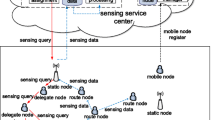Abstract
Increasing demands of data transmissions are promoting the acceleration of peaking rate per terminal especially in hot-spots. Numerous irregular deployments of small cells require efficient tracking area (TA) planning method in heterogeneous cellular networks. Macrocells preferred access is not a fundamental solution for TA planning, which results from reducing the offloading ability of small cells. In this paper, a novel TA planning algorithm based on cooperative games is proposed by detecting similar communities. Simulation results show that it can reduce the signalling overhead, improve the performance of calling successes and system utilizations while maintaining the offloading abilities of small cells.








Similar content being viewed by others
References
Zhang H, Chu X, Guo W, Wang S (2015) Coexistence of wi-fi and heterogeneous small cell networks sharing unlicensed spectrum. IEEE Commun Mag 53(3):158–164
Zhang H, Jiang C, Beaulieu NC, Chu X, Wang X, Quek TQ (2015) Resource allocation for cognitive small cell networks: A cooperative bargaining game theoretic approach. IEEE Trans Wirel Commun 14 (6):3481–3493
Andrews JG, Claussen H, Dohler M, Rangan S, Reed MC (2012) Femtocells: past, present, and future. IEEE J Sel Areas Commun 30(3):497–508
Andrews JG (2013) Seven ways that hetnets are a cellular paradigm shift. IEEE Commun Mag 51(3):136–144
Andrews JG, Buzzi S, Choi W, Hanly SV, Lozano A, Soong AC, Zhang JC (2014) What will 5g be? IEEE J Sel Areas Commun 32(6):1065–1082
Bangerter B, Talwar S, Arefi R, Stewart K (2014) Networks and devices for the 5g era. IEEE Commun Mag 52(2):90–96
Fortes S, Aguilar-garcía A, Barco R, Barba F, Fernández-luque J, Fernández-Durán A (2015) Management architecture for location-aware self-organizing lte/lte-a small cell networks. IEEE Commun Mag 53(1):294–302
Ning L, Wang Z, Guo Q, Zhang H (2016) Dynamic pci assignment in two-tier networks based on cell activity prediction. Electron Lett 52(10):879–881
Ning L, Wang Z, Guo Q (2014) Preferred route indoor mobility model for heterogeneous networks. IEEE Commun Lett 18(5):821–824
Zhang H, Jiang C, Hu RQ, Qian Y (2015) Self-organization in disaster resilient heterogeneous small cell networks. IEEE Network. arXiv:1505.03209
Zhang H, Jiang C, Cheng J (2015) Cooperative interference mitigation and handover management for heterogeneous cloud small cell networks. IEEE Wirel Commun 22(3):92–99
Ferragut J, Mangues-Bafalluy J (2012) A self-organized tracking area list mechanism for large-scale networks of femtocells. In: Communications (ICC), 2012 IEEE international conference on, pp. 5129–5134. IEEE
Chatzikokolakis K, Kaloxylos A, Spapis P, Alonistioti N, Zhou C, Eichinger J, Bulakci O (2014) A survey of location management mechanisms and an evaluation of their applicability for 5g cellular networks. Recent Adv Commun Netw Technol 3(2):106–116
Fu HL, Lin P, Lin YB (2013) Reducing signaling overhead for femtocell/macrocell networks. IEEE Trans Mob Comput 12(8):1587–1597
Toril M, Luna-ramírez S, Wille V (2013) Automatic replanning of tracking areas in cellular networks. IEEE Trans Veh Technol 62(5):2005–2013
Yu Y, Gu D (2013) The cost efficient location management in the lte picocell/macrocell network. IEEE Commun Lett 17(5):904–907
Han Z (2012) Game theory in wireless and communication networks: theory, models, and applications. Cambridge University Press, Cambridge
Zhou L, Cheng C, Lü K., Chen H (2013) Using coalitional games to detect communities in social networks. In: Web-age information management, pp. 326–331. Springer
Chu X, López-Pérez D, Yang Y, Gunnarsson F (2013) Heterogeneous cellular networks: Theory, simulation and deployment. Cambridge University Press, Cambridge
ElSawy H, Hossain E, Haenggi M (2013) Stochastic geometry for modeling, analysis, and design of multi-tier and cognitive cellular wireless networks: A survey. IEEE Commun Surv Tutorials 15(3):996–1019
Acknowledgments
This work has been sponsored by the China Scholarship Council (No. 201406120100) and National Natural Science Foundation of China (No. 61101125 and 61571316). Meanwhile, the authors would like to thank anonymous for improving the quality of this paper.
Author information
Authors and Affiliations
Corresponding author
Rights and permissions
About this article
Cite this article
Ning, L., Wang, Z., Li, D. et al. Tracking Areas Planning Based on Community Detection in Heterogeneous and Small Cell Networks. Mobile Netw Appl 22, 529–538 (2017). https://doi.org/10.1007/s11036-016-0763-z
Published:
Issue Date:
DOI: https://doi.org/10.1007/s11036-016-0763-z




